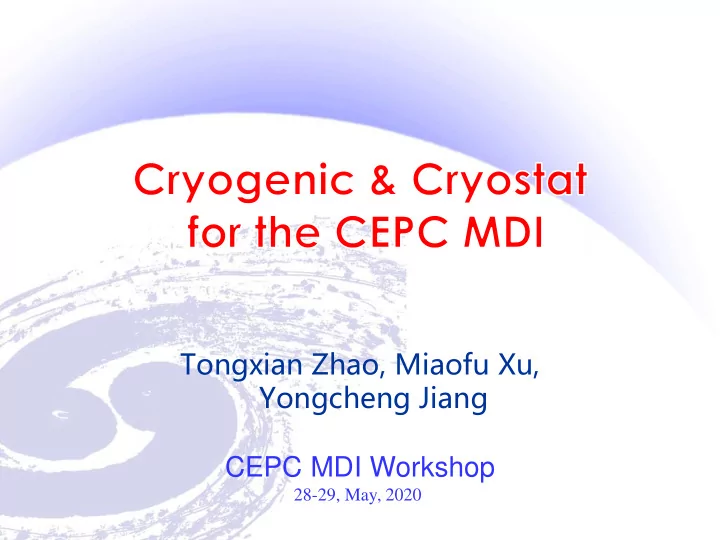

Tongxian Zhao, Miaofu Xu, Yongcheng Jiang CEPC MDI Workshop 28-29, May, 2020
◼ Introduction ◼ Cryogenic cooling schemes and Cryogenic Layout for MDI ◼ Cryogenic system design considerations ◼ The Cryostat of MDI ◼ Cryostat Prototype Plan& Key technology ◼ Manpower ◼ Summary
The Machine Detector Interface (MDI) IR magnets: ➢ 4 IR magnets ➢ 32 Sextupole magnets, ➢ 36 cryomodules/18 @each station ➢ Temperature: 4.5K (2K) Sketch of CEPC Collider ring CEPC MDI SC Magnets (superconducting QD0,QF1, anti-solenoid ) in a helium vessel.
Surface Cryogenic Equipment IR magnets area Underground service area One Cold box and two MDI service cryostat are installed on each IP point, should be close enough to the user. Sextupole magnets share a CB with MDI, they need to be considered together. Refrigerator with the cooling capacity of 3kW@4.5K will be employed for each cryo-stations.
2K 4.5K 4.5K Pressurized He II (subcooled liquid) Saturated He I Saturated He II Superconducting equipment Coolant condition Heat Load Sextupole magnets 4.5K(2K) 16*10W@4.5K(2K) QD0, QF1 and anti-solenoid Below 2K 4*30W@2K • 2K helium has powerful stabilization against thermal disturbances(large C/excellent λ ) • Superfluid helium can permeate to the heart of magnet windings(low bulk viscosity) • To determine actual cooling capacity safety factor and extra heat load has to be considered. • With the change of operating temperature we also have to reconsider actual thermal load for these equipment.
To VB 4K Surface Cryogenic Equipment Underground service area From CB IR magnets area cryostat 2K 101.3kPa 2K 5kPa • The MDI cold masses will be cooled in a pressurized static superfluid helium bath at 101.3kPa and at a temperature of 2K, so we need a 2K refrigerator in the tunnel . • The 5kPa vapor pressure is maintained by a cold compressor system • The final operating temperature and pressure are determined by the cryogenic process calculation
◼ The cryogenic systems incorporate high efficiency helium refrigeration (liquefaction) at 4.5 K, a distribution system with low heat-in leaks ,a large helium inventory (storage) and the cryogenic users (cryostat). ◼ The design of the cryostat and cryogenics system allowed the prior testing of the full cryogenic loop without magnet. ◼ CEPC cryogenic system should allow for rapid cool-down and warmup of limited lengths of the strings, e.g. for repairing or exchanging a defective unit. ◼ To ensure reliable operation, it should provide reasonable redundancy of functions among its components and sub- systems ◼ Personnel and equipment safety
The Struct ucture ure of Cryost ostat at Magnet-cryostat design: QD0, QF1, and anti-solenoid • coils are in the same cryostat. The cooling scheme will be • determined by the final design of the magnet structure Self-centered supports are • designed to make the magnet Magnet cryostat Weight(Kg) positions after cool-down the ≈ 1097.87 Total cold mass nominal positon for the beam ≈ 537.87 Lhe vessel operation. • ≈ 560 Magnet From Miaofu Xu
The Struct ucture ure of Cryost ostat at The helium vessels, in which the SC • magnets are assembled, are supported by the 8 rods from the vacuum vessel. To be made of non-metallic materials • such as Carbon fiber (CFRP , T300) The multilayer insulation material • and it’s dressing process is very important to decrease the heat load From Miaofu Xu *Study on heat leak of multilayer insulation(MLI)
The e Cooling ling met ethod od of Cryostat yostat Subcooler He II saturated Subcooled He ~4.5K He II saturated, flowing Heat exchanger tube He II pressurized, static • Subcooled helium ~4.5K • Pressurized saturated superfluid helium • Forced-flow convection of pressurized superfluid helium • Two-phase flow of saturated superfluid helium
◼ Plan A . Large refrigerator ⚫ There are 2 cryo-stations, each one with a refrigerator of 3kW@4.5K ⚫ low cost of daily maintenance. ⚫ The CTL is long and the cost is high ( ~214 million ) ◼ Plan B. Large refrigerator +GM refrigerator ⚫ There are 2 cryo-stations, each one with a refrigerator of 500W@4.5K ⚫ Each sexupole magnet is equipped with a GM refrigerator unit, totally 32 groups. ⚫ If GM refrigerator is adopted, there is no cryogenic transfer line (SM), ⚫ But the maintenance of the GM refrigerator is more difficult. ⚫ Low cost ( ~174 million ) , no long-distance CTL. ⚫ 128 GM refrigerators and 2*500W(4*250W) refrigerators, high cost of daily maintenance and high failure rate. ◼ Plan C . 2K Refrigerator
• We needs to make a cryostat prototype to find many unforeseen problems. • Heat exchange for the cryostat. • High-performance cryogenic transfer line. • The pressurized static superfluid helium bath technology. • Cold compressor station.
Cryogenic transfer lines are typical components of almost all cryogenic systems.They are intended for transferring cryogenic fluids between two cryogenic devices. We need high-performance cryogenic transfer lines for reduce the heat leak. We will build a test stand for the CTL heat loss measurement, design CEPC CTL.
◼ Cryostat design | Miaofu Xu ◼ Cryogenic system | Yongcheng Jiang ◼ Thermodynamic simulation | Tongxian Zhao ◼ Layout design | Jiang , Zhao ◼ Cryostat Prototype Development | Xu, Zhao ◼ Key technology of cryogenics | Jiang, Zhao ◼ Cryogenic Transfer Line | Jiang ◼ Cryogenic Measurements | Zhao ◼ Cryogenic Control system | Cryogenic Group
◼ The cryostat will be optimized follow the process of magnets. ◼ MDI Dynamic heating should be provide. ◼ Precision Thermometry. ◼ Test Stand for the CTL. ◼ Cryostat Prototype is necessary. ◼ Research on 2K cooling scheme.
Thanks for your attention
*No contingency
Recommend
More recommend